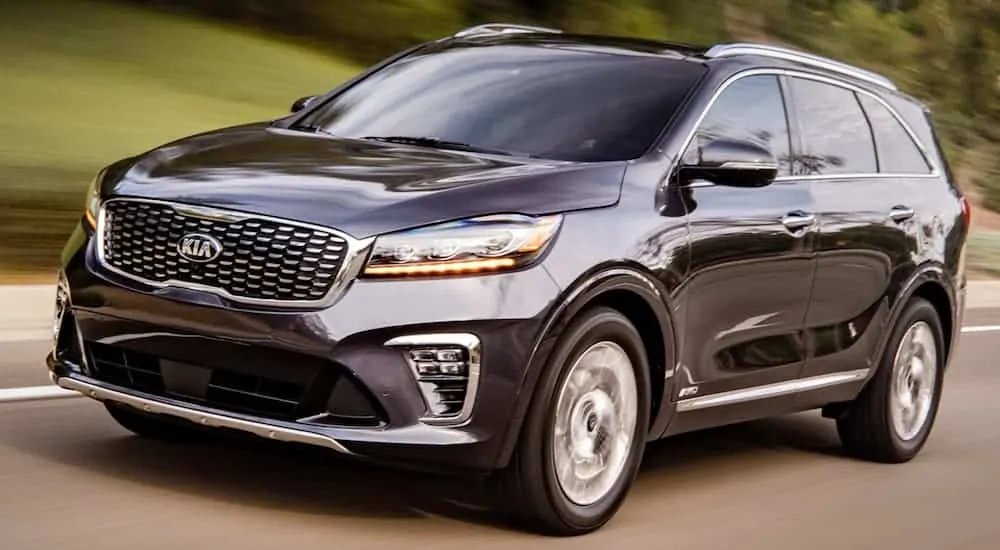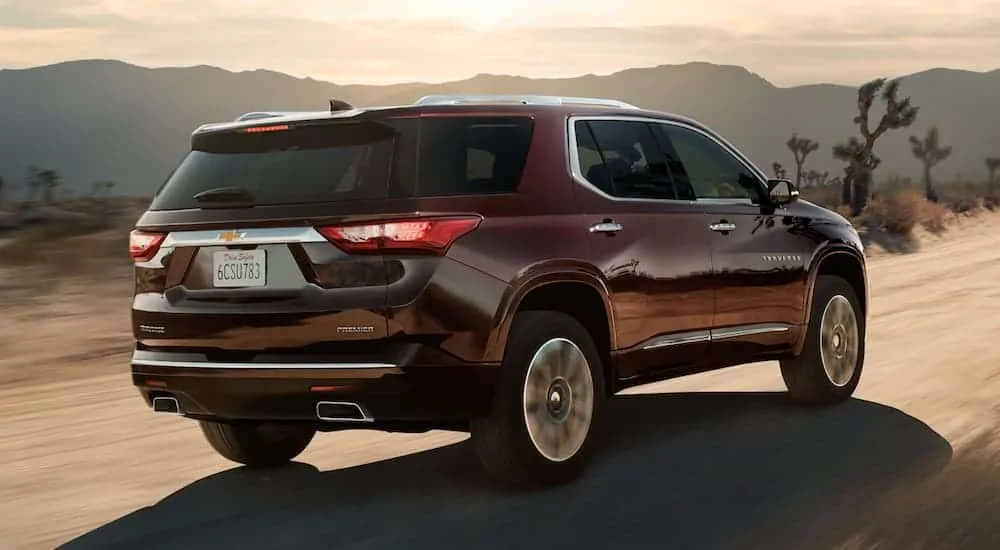When you need to traipse large numbers of people around, but you just can’t bring yourself to own a minivan, midsize SUVs save the day. And once you realize you want a midsize SUV, you’re faced with a sea of options, including fan-favorites, the 2020 Chevy Traverse vs 2020 Kia Sorento. And today, we are going to compare how these two SUVs match up in terms of capability, cargo space, technology, and comfort, to help determine which midsize SUV is really the best of the best. So without further ado, let’s get into it!
Comparing Capability
To understand the capability of a vehicle, the engine is where you must begin. Chevy has recently made a bold move to stick with a single-engine for all trim levels of the 2020 Traverse. Every trim comes with a 3.6-liter V6 engine with a 9-speed transmission and front-wheel drive. However, the option to add all-wheel drive is available on all trims. It has start-stop technology to save on gas, and it has been reported as one of the smoothest rides on the market. With this V6 engine, you can tow between 1,500 and 5,000 pounds, depending on which trim level you buy.
Kia offers buyers options in engines on the 2020 Sorento, starting with a 2.4-liter four-cylinder engine with six speeds. This engine comes standard on the L and LX trims and is paired with front-wheel drive. The other engine option is a 3.3-liter V6 with an 8-speed transmission, available for the S, EX Sport, and SX trims. All-wheel drive is available for all but the L trim, and depending on the engine you choose, the 2020 Sorento will tow from 2,000 to 5,000 pounds.
It’s all well and good to throw numbers around, but even when you compare the numbers for engine power, the Chevy comes out on top. Kia’s four-cylinder will have a hard time with a large load of people when you have a full vehicle, especially if they are adults. Even with the V6, Kia’s engine is not as powerful, with only 290 hp compared to Chevy’s 310 hp. This will be even more of an issue if you decide to tow a trailer with a full load of people and luggage. In general, the Traverse is much more capable of traversing than the Sorento. But it is important to note that this is only part of the comparison; there is much more to consider!

Cargo Space and Seating
If you’re going to buy a three-row vehicle, it’s always a plus when all three rows are actually usable for passengers of all sizes. All too often, the back row ends up being good only for small children, and this seems to be the case for the Kia Sorento. In all fairness, the Sorento is on the smaller side of midsize. It may be unfair to compare it to the larger Traverse, but here the Traverse really steals the show.
Beginning with seating, the Traverse has room for either seven or eight, depending on the configuration you choose. Different trim levels have the option of captain’s chairs in the second row, which takes the capacity down to seven. The Sorento only has room for seven. Period. When you look at the space available for the passengers, the Traverse makes the most of its three rows by giving plenty of space to the forgotten realm of the third row. Even adults can fit comfortably, especially with the ease of the sliding seats in the second row. Sorento simply misses the boat on this comparison, with a tight squeeze in the third row that can only be accessed by the passenger side.
Both vehicles have the capability to stow all the seats in the floor to make the cargo space flat for transport, making them quite versatile. However, cargo capacity is also almost unfair to compare. The Chevy Traverse manages to provide up to 98.2 cu.ft. with all the seats folded down in comparison to the Kia Sorento’s 73 cu.ft. with the seats down. And while that number is impressive on its own, it’s far smaller than the Traverse, bringing the Traverse to the top of the competition yet again.
A Glance at Technology
At this point in the world of all transportation, any vehicle that hits the price point of a midsize SUV should come standard with certain tech features. Here, at least, both the Sorento and the Traverse come standard with Apple CarPlay and Android Auto, a seven-inch touchscreen, and a six-speaker audio system for all trim levels, but what other features do they have in store? Once again, the comparison is a wide rift between the two models.
Chevy adds its own Infotainment 3 system to all trim levels, with upgrades to upper trims. With this system, you get Bluetooth streaming for two devices, voice command pass-through to your smartphone, enhanced voice recognition with in-vehicle apps, and storage of your personalized infotainment and vehicle settings through the cloud Chevy provides when you subscribe. Also add to this a 4G LTE hotspot, OnStar connection, and six USB ports (two in each row). The option for wireless charging, universal home remote, universal tablet holders, Sirius XM, and a rear-seat entertainment system are all available for upper trims.
Kia provides the Sorento with four 12-volt power outlets, one USB auxiliary jack, and Bluetooth as standard for all trims. In order to have the desirable UVO system with voice navigation, HD radio, Sirius XM, and wireless charging, you have to purchase the SX trim, which is the most expensive. For that trim level, you also gain an eight-inch infotainment screen, but there is no option at all for a rear entertainment system. The biggest upgrade for the Kia is the Harmon Kardon sound system on the top trim. Once again, the Chevy takes the cake.
Creature Comfort
Comfort features like cruise control and powered accessories make a world of difference when you experience the ease of travel with their convenience. Due to the price point of both these vehicles, the manufacturers offer fairly comfortable seating and interior layout of the first two rows. Both the Traverse and the Sorento come with cruise control, steering wheel-mounted controls, a rearview camera, remote entry, a tilting and telescoping steering column, heated wing mirrors, and powered windows and door locks. Features diverge from there.
From the base trim level, the Traverse offers tri-zone climate control with a humidity sensor that monitors the environment, remote entry, and manually-operated seats. Through the trim levels, the options increase to include powered and heated front seats with lumbar control, ventilated seats, heated rear seats, automatic heated steering wheel, rear camera mirror, and memory settings for the driver’s seat. Chevy adds to all the trims an innovative and probably much-desired feature for anyone who lives in a rainy climate: umbrella holders.
Kia’s Sorento only gets dual-zone automatic climate control with mid-level trims, along with the other features like powered adjustable seats, heated front seats, smart key with engine immobilizer, and powered door lock with speed sense and impact unlock. Features like the auto-dimming rearview mirror with Homelink and driver’s seat with memory are reserved for the top trim only. Features from upper trims that both vehicles share are the addition of a sunroof and powered programmable liftgate, while both vehicles have rear tinted windows and solar-absorbing glass on all trim levels. Once again, the Traverse delivers more right out of the gate for features of both comfort and convenience.
The Better Choice: Chevy Traverse
In each of the categories, the 2020 Chevy Traverse edges out the 2020 Kia Sorento in almost every way. From the standard features on all trims to the optional features on upper trims, Chevy simply adds more of everything. Whether you want the power to tow, the space to haul, or the room for passengers, the Chevy will give the better value. For a family trip, the Traverse will be far more comfortable and offers far more tech and entertainment options on all trim levels. Overall, the 2020 Chevy Traverse will give buyers looking for a midsize SUV a far better experience.





